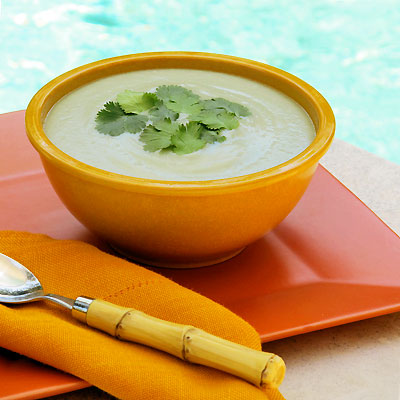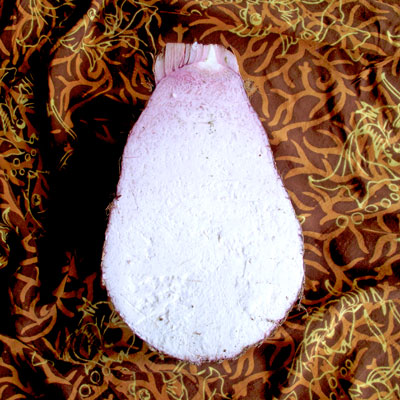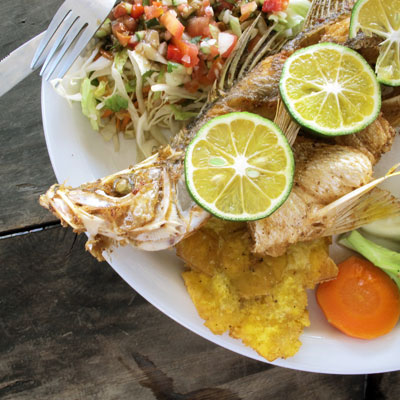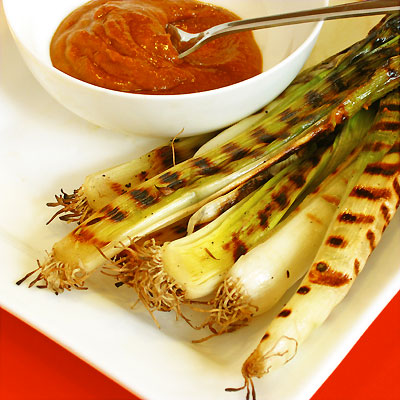
Well, my Costa Rican adventure draws to a close. It’s time to thank my hosts with something special and tasty. I decided I wanted to take a local tropical ingredient– some might even say a humble ingredient and use it in a stylish way that most people may have never considered.
I chose taro root. And I chose to use it as a substitute for potato in a chilled tropical vichyssoise. I chose to bake the taro first because it really helps deepen the nutty flavor. Coconut milk adds a level of luscious creaminess, and a touch of curry brings a few more exotic notes.
Just so you know, taro is also known as dasheen or daro, and well– countless other names. The diversity of nomenclature comes from the fact that taro is a root that feeds the world. Different cultures have different names, and different areas have slightly different varieties. Because it’s the root from a diverse group of plants known as Elephant Ear. It is a staple and a very healthy and versatile starchy crop.
 All this diversity almost led to a disaster, however. That’s because I thought I knew what taro was when I arrived in Costa Rica. I just assumed I would see it wherever I went shopping. Because, as I said it’s a dietary staple in tropical regions. But every store I went to had plenty of brownish looking roots, but none of them seemed to be the taro with which I was familiar. I even asked (as well as I could) if they had taro in the store. The answer was always no! Eek panic. I had already committed my cooking demo to taro & coconut milk vichyssoise. There was no turning back.
All this diversity almost led to a disaster, however. That’s because I thought I knew what taro was when I arrived in Costa Rica. I just assumed I would see it wherever I went shopping. Because, as I said it’s a dietary staple in tropical regions. But every store I went to had plenty of brownish looking roots, but none of them seemed to be the taro with which I was familiar. I even asked (as well as I could) if they had taro in the store. The answer was always no! Eek panic. I had already committed my cooking demo to taro & coconut milk vichyssoise. There was no turning back.
Well, twitter to the rescue. Because one tweet led to the answer. In Costa Rica, taro is more commonly known as dasheen! Crises averted. Every store I went to had dasheen. It was a similar brown root; it is just smaller than the version I was used to seeing in Los Angeles. GREGGREG
- 1 1⁄2 lb taro root
- 1⁄2 c coconut syrup
- salt & white pepper as needed
- 2 T unsalted butter, plus more for dish
- 2 leeks, white and pale green parts, chopped, washed and dried
- 2 small spring or sweet onions, peeled & chopped
- 4 c chicken stock, plus more if necessary
- 1 c coconut milk
- 1 t curry powder
- cilantro leaves, for garnish
Instructions
Wearing gloves if you are sensitive, completely peel the taro. Then halve it lengthwise and cut it into 3/4‑inch cubes. Add the cubes to a large bowl and cover them with cool water and allow them to soak about 30 minutes to remove some of the starch (optional).
Preheat the oven to 375 degrees F. Add the taro to a large pot of salted water, bring to a boil, then lower the heat to a simmer. Parboil the taro until just beginning to soften. About 7 minutes. Drain the taro, returning it to the bowl.
While the taro is still warm drizzle the coconut syrup over it and adds salt and pepper to taste and mix it well to get the taro completely coated.
Pour the taro into a buttered baking dish. Cover the dish tightly with foil.
Bake in the preheated oven about 30 minutes. Remove from oven, allow to cool uncovered.
In a large saute pan melt the butter over medium heat. Saute the leeks and onions with a pinch of salt. Cook until translucent, but not yet colored. Add the cooked taro to the pan along with the chicken stock. Bring the mixture to a boil, then turn off the heat allowing the mixture to cool somewhat.
Working in batches, puree the mixture in a food processor or blender. Add the coconut milk and curry. Running the machine until completely smooth. Pour the pureed soup to a large covered bowl or tureen and adjust the consistency with a bit more stock if needed. Adjust seasoning. Cover and refrigerate at least 2 hours until well chilled. Garnish with cilantro, and serve.



My next question to you was going to be “which day was the farmers’ market?” Sunday. Cool. 🙂
I’m glad you were able to cool your jets and take a second pass. I always look for the details taht make other markets different than my home market (Saturday Irvine Farmers Market), like the ceramics you found here that you wouldn’t exactly find in Hollywood. Oh, and linens — did you happen to notice anyone making local linens? Because I like to collect those. 🙂 Tres chic for my garden “tablescapes.”
Did I really just say tablescape? Guess I did.
Cheers!
[K]
I like how you dressed to match the carrots! Did you buy any local olive oil? Wondering how it is. Last time I was in Ojai (several months ago) I stopped in Ventura on the way home, and there was an olive oil store with a ton of olive oils on tap. Would love to go back and do a tasting.
Did you make it to the Beatrice Wood Center? My sister was her caretaker, there when she passed away at 105.
Quite a pistol that ol’ gal! You definitely would have liked her Greg.
LL
Very interesting visit! I think many countries (like mine!!) should copy this type of community project…
By the way, I thought of you the other day since I went to Raquel Carena’s restaurant..Among her first courses, there was a “fromage de tête” that is actually no cheese, but a kind of pâté made with the head of the pig that is apparently the tastiest part…That was “deep france” tradition..It was great!
Have a nice WE
Glad that you were able to refocus how you saw it and come away with things in a more positive light. It’s definitely hard because in towns like that you’re much closer to the source, but the population for the market is much smaller so it unfortunately can’t reach quite the size it does in the city. I love my local farmers’ market, but the one thing that disapoints me is that there isn’t more variety in what is sold, by which I mean more heirloom varities and wacky stuff. I understand it because they are going to sell what consumers are buying but at the same time it’s tough.